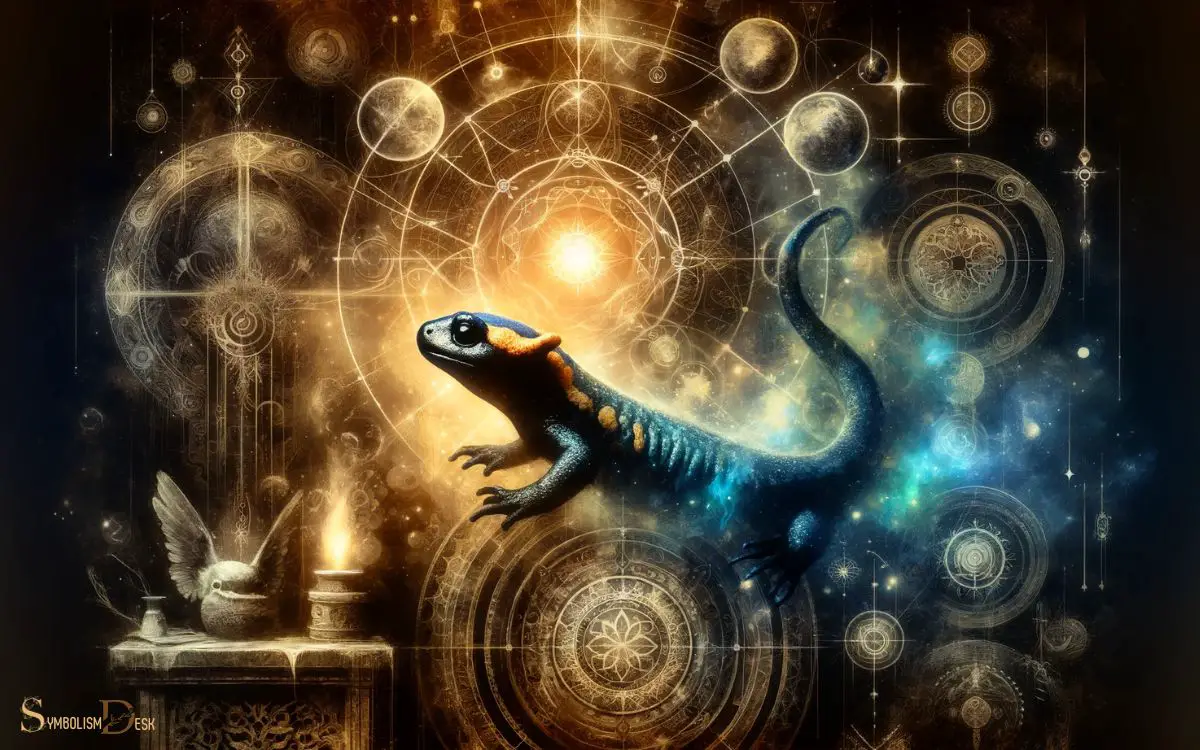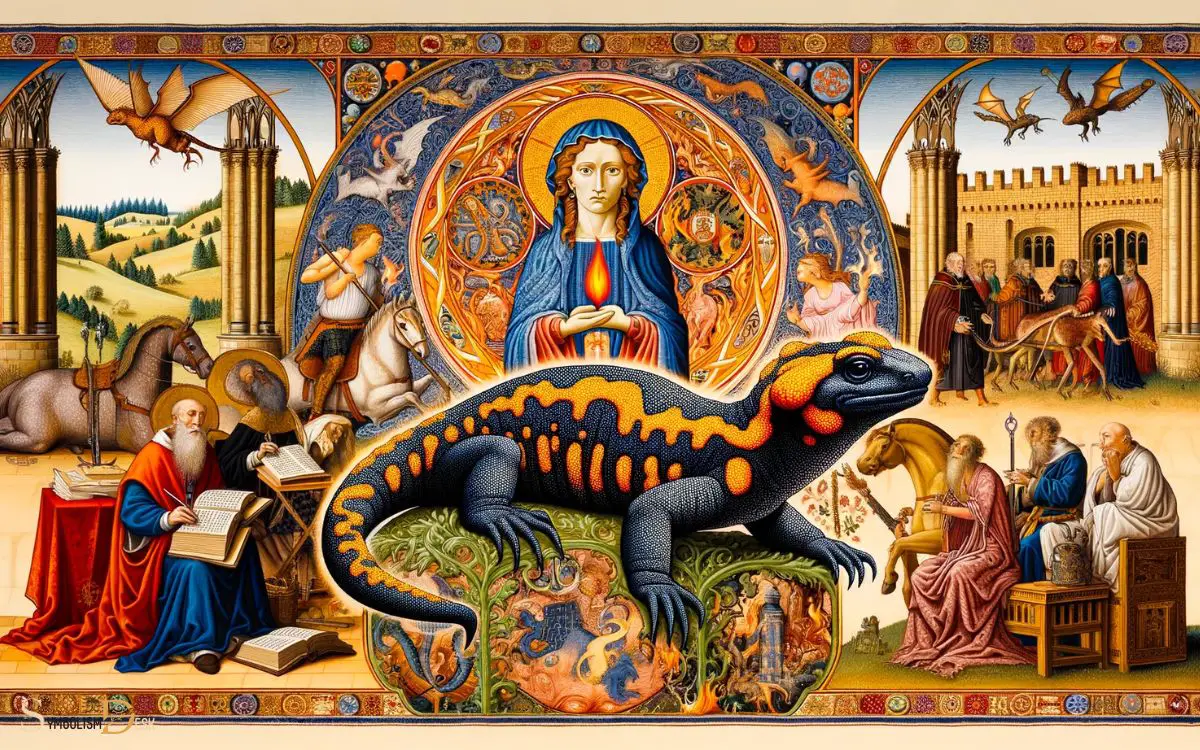What Does a Salamander Symbolize Spiritually? Rebirth!
The salamander symbolizes a range of spiritual concepts including transformation, rebirth, resilience, and protection. It is often associated with fire due to ancient beliefs that it could withstand flames.
This small amphibian holds deep spiritual significance and continues to be a symbol of enduring strength and adaptability in many cultural traditions.
In spiritual symbolism, the salamander represents:
- Transformation and Rebirth: Just as the salamander can regenerate lost limbs, it symbolizes the ability to renew oneself and emerge stronger from adversity.
- Resilience and Protection: Its mythical association with fire speaks to its capability to survive and thrive in harsh conditions, symbolizing protection and resilience.
- Purity and the Elemental Force of Fire: In alchemy, the salamander is connected with the element of fire, representing purification and the transformation of the soul.
For example, in alchemical texts, the salamander is often depicted amidst flames, illustrating its purported ability to exist within fire, a metaphor for the refinement and conversion of the base elements of the human soul into something pure and enlightened.
Embrace the salamander’s spirit to ignite your inner transformation and emerge with renewed strength, symbolizing an unyielding spirit that thrives against all odds.

Key Takeaway
Ancient Mythology and Salamander Symbolism

The significance of salamanders in ancient mythology is rooted in their association with elemental forces and transformation. In various cultures, these amphibians were believed to possess potent spiritual symbolism.
In European folklore, salamanders were often linked to the element of fire, as they were thought to be born from and able to withstand flames.
This association with fire led to the belief that salamanders possessed purifying and transformative powers.
Additionally, in alchemical traditions, the salamander represented the process of spiritual purification and the ability to endure intense trials, symbolizing the transformative journey of the soul.
These ancient mythological connections have contributed to the enduring spiritual symbolism of the salamander, representing resilience, purification, and the power of transformation in the collective consciousness.
Salamander Symbolism in Eastern Spirituality

In Eastern spirituality, salamanders are considered to embody elemental forces and undergo transformative processes, contributing to their enduring spiritual symbolism.
In Eastern traditions such as Hinduism and Buddhism, the salamander is often associated with the element of fire.
It represents the intense energy and transformative power of this element, symbolizing the process of burning away impurities to reveal the true nature of the soul.
Additionally, salamanders are linked to the concept of rebirth and renewal, mirroring their ability to regenerate lost limbs.
This symbolism aligns with the Eastern spiritual belief in the cyclical nature of existence and the potential for spiritual evolution.
The salamander’s portrayal in Eastern spirituality emphasizes the profound connection between elemental forces, transformation, and spiritual growth.
Salamander Symbolism in Western Traditions

Salamander symbolism in Western traditions further explores the creature’s association with elemental forces and transformative processes.
In Western alchemy, the salamander is linked to the element of fire, representing purification and the ability to endure intense heat without harm.
This association with fire aligns with the salamander’s depiction as a resilient and powerful creature, capable of withstanding fiery trials.
Additionally, the salamander’s regenerative abilities have led to its symbolism as a creature of rebirth and renewal in Western folklore. Its ability to survive in harsh environments has also been interpreted as a symbol of resilience and adaptability.
Salamander Symbolism in Alchemy and Esotericism

Associated with mystical practices, alchemy, and esotericism, the salamander’s symbolism delves into its enduring ties to elemental forces and transformative processes.
In the realm of alchemy and esotericism, the salamander represents profound spiritual concepts and universal truths, captivating the imagination and curiosity of seekers.
Its symbolic significance encompasses:
- Elemental Mastery: The salamander embodies mastery over the element of fire, signifying spiritual purification and the transformative power of overcoming obstacles.
- Regeneration and Rebirth: Its association with fire links the salamander to the concept of regeneration and rebirth, symbolizing the cyclical nature of life and spiritual evolution.
- Inner Alchemy: The salamander’s symbolism is intertwined with inner alchemy, representing the inner transformation and purification of the soul.
- Transmutation: It symbolizes the alchemical process of transmutation, reflecting the journey of spiritual growth and enlightenment.
This symbolism offers a profound understanding of the salamander’s significance in alchemical and esoteric traditions, inspiring introspection and spiritual contemplation.
What is the Spiritual Meaning of Rebirth in Different Symbolic Animals?
In many cultures, the medusa symbolism and rebirth are intertwined within the spiritual meanings of different animals. The snake, for example, represents transformation and rebirth due to its ability to shed its skin and emerge anew. Similarly, the butterfly symbolizes rebirth and spiritual growth through its transformation from a caterpillar.
Contemporary Interpretations of Salamander Symbolism

Contemporary scholars and spiritual practitioners offer diverse interpretations of the salamander’s symbolism, reflecting evolving perspectives on its spiritual significance.
In modern spirituality, the salamander is often associated with the power of transformation and regeneration. It represents the ability to endure and thrive in adverse conditions, serving as a symbol of resilience and adaptability.
Furthermore, some interpret the salamander as a representation of the life force and the interconnectedness of all living things, emphasizing the importance of environmental conservation and harmony with nature.
Additionally, in some contemporary spiritual practices, the salamander is viewed as a guide through emotional and spiritual depths, symbolizing the courage to confront and overcome inner challenges.
These interpretations demonstrate the timeless relevance of the salamander’s symbolism in inspiring and guiding individuals in the present day.
Conclusion
The symbolism of the salamander spans across ancient mythology, Eastern spirituality, Western traditions, alchemy, and contemporary interpretations.
The salamander represents transformation, regeneration, and the ability to overcome obstacles. Its presence in various cultural and spiritual contexts highlights its enduring significance as a symbol of resilience and inner strength.
The salamander’s symbolism persists through time, serving as a reminder of the human capacity for growth and renewal.






